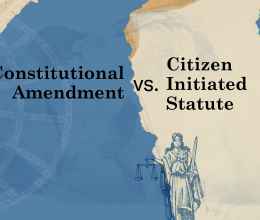As many Ohioans prepare to celebrate Passover and Easter, it is a fitting time to reflect on a continued injustice that folks from across the faith spectrum are mobilizing in growing numbers to repeal – Ohio’s death penalty.
There are many reasons capital punishment in the Buckeye state needs to go by the wayside – its high cost, its arbitrary and disparate impact based on where you live or the color of your skin, innocence concerns, and so on. At its core, putting someone to death is an inhumane act. In doing so, we empower our government to be judge, jury, and executioner; we deny that individual any chance of redemption, a core tenet of both Judaism and Christianity.
The Christian faith teaches that Jesus preached turning the other cheek when faced with violence, not the “eye for an eye” approach that capital punishment represents. Meanwhile, the rabbis who wrote the Talmud erected so many barriers to capital punishment as to make it “almost impossible” to put anyone to death. Two of these rabbis said, “if we had been in the Sanhedrin, no one would have ever been put to death.” A passage from the Mishnah Sanhedrin holds that “he who destroys one life, it is as though he had destroyed all humankind; whereas he who preserves one life, it is as though he preserved all humanity."
In allowing the death penalty to remain on the books, we become blind to its injustice and inhumanity. We also ignore what co-victims actually need, in the name of pursuing revenge. Revenge does not serve justice. Jonathan Mann, a co-victim and vice chair of Ohioans to Stop Executions, has spoken on how the legal process for capital cases affects co-victims: “while the person that caused our pain may eventually go away too, it doesn’t fill the hole in our hearts.”
Instead of choosing the ultimate punishment, let us focus on forgiveness, and grant these individuals an opportunity to reflect on what they have done. We must remember that our criminal justice system is intended not solely for correction but also for rehabilitation.
Those who have been wrongfully convicted and sentenced, including the 11 exonerees in Ohio’s history of capital punishment, face an unthinkable fate – certain death, for a crime they did not commit. The possibility of executing an innocent person should be justification enough for Ohio to finally remove this barbaric practice from state law. For every five people the state of Ohio has executed, one has been found innocent. For religious and non-religious folks alike, this reality should violate every aspect of our shared moral code.
On top of that, the state has not carried out an execution in nearly three years because of an inability to procure lethal injection drugs, resulting in a de facto moratorium. Prior to that, the state experienced five badly botched executions from 2006 to 2017. Not only are we unable to currently execute, and not only have folks been wrongfully sentenced, but we also could not guarantee that the execution would be carried out without gruesome mistakes.
Human error in the legal process of capital cases is evident in other ways too – Attorney General Dave Yost recently noted in his annual Capital Crimes Report that many death sentences have been removed “because of legal errors, such as ineffective assistance of counsel [and] Brady violations,” among other issues. Brady violations refer to a violation of the “Brady Rule,” established in Brady v. Maryland, which requires prosecutors to present to the defense any exculpatory evidence in the government’s possession. This means people on Ohio’s death row are being removed because prosecutors had manipulated or withheld evidence from judges and juries.
Now, acknowledging the existence of Brady violations in these cases is an admission that prosecutors in some of these cases have not always presented all evidence. Yet, Attorney General Yost attempts to use this as justification for keeping the death penalty, contending, “these removals show the appellate process working as it should to prevent an injustice.”
If these removals have been so frequent and riddled with errors, shouldn’t we consider the possibility that the process is not working as it should?
For the myriad reasons listed above, the death penalty is not working for Ohio.
Fortunately, the prospects of death penalty repeal are stronger than ever. This progress comes thanks to a bipartisan, bicameral team of Ohio lawmakers and a broad coalition of stakeholders, including conservative, liberal , and faith groups – the Catholic Conference of Ohio, the Ohio Council of Churches, and the Ohio Religious Action Center of Reform Judaism, to name a few.
House Bill (HB) 183, jointly sponsored by Representatives Jean Schmidt and Adam Miller, has received five hearings in the Ohio House Criminal Justice Committee, more than any death penalty abolition bill in the past. Meanwhile, Senate Bill (SB) 103, jointly sponsored by Senators Steve Huffman and Nickie Antonio, has received two hearings in the Ohio Senate Judiciary Committee.
Public support for repeal is at an all-time high. Some 59 percent of Ohioans support replacing the death penalty with life in prison without the possibility of parole. Additionally, 59 percent of households with a member employed in criminal justice – folks who interact with these systems on a daily basis – support repeal. Counter to those who suggest that we need to reserve the death penalty for the “worst of the worst,” 54 percent of respondents prefer a life sentence to the death penalty when asked what the punishment should be for first-degree murder.
As Rev. Dr. Jack Sullivan, Jr., executive director of the Ohio Council of Churches and the family member of a victim, said in testimony supporting HB 183, “Homicide to show that homicide is abhorrent, is itself, abhorrent.”
The time is now to choose mercy over vengeance. Abolishing Ohio’s death penalty would be an act of love, compassion, and humanity. For all Ohio lawmakers celebrating or observing Easter and Passover in the coming days, we respectfully urge them to think critically about how to live out the teachings of their faith in practice: by voting to abolish capital punishment.
To find out how you can join the fight, the official campaign to end Ohio’s death penalty, No Death Penalty Ohio, has more information.








